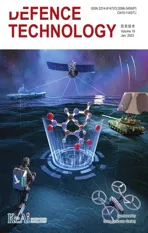Blast wave characteristics of multi-layer composite charge:Theoretical analysis,numerical simulation,and experimental validation
2023-01-19JunLiWeiingLiXiowenHongJixinYuJinjunZhu
Jun-o Li ,Wei-ing Li ,*,Xio-wen Hong ,Ji-xin Yu ,Jin-jun Zhu
a ZNDY of Ministerial Key Laboratory,Nanjing University of Science and Technology,Nanjing,210094,China
b Inner Mongolia Metal Material Research Institute,Yantai,264003,China
c China Ship Development and Design Center,Wuhan 430064,China
Keywords:Blast wave characteristics Multi-layer composite charge Dimensional analysis AUTODYN mapping Model Explosion experiment
ABSTRACT This article investigates the characteristics of shock wave overpressure generated by multi-layer composite charge under different detonation modes.Combining dimensional analysis and the explosion mechanism of the charge,a peak overpressure prediction model for the composite charge under singlepoint detonation and simultaneous detonation was established.The effects of the charge structure and initiation method on the overpressure field characteristics were investigated in AUTODYN simulation.The accuracy of the prediction model and the reliability of the numerical simulation method were subsequently verified in a series of static explosion experiments.The results reveal that the mass of the inner charge was the key factor determining the peak overpressure of the composite charge under single-point detonation.The peak overpressure in the radial direction improved apparently with an increase in the aspect ratio of the charge.The overpressure curves in the axial direction exhibited a multi-peak phenomenon,and the secondary peak overpressure even exceeded the primary peak at distances of 30D and 40D (where D is the charge diameter).The difference in peak overpressure among azimuth angles of 0-90° gradually decreased with an increase in the propagation distance of the shock wave.The coupled effect of the detonation energy of the inner and outer charge under simultaneous detonation improved the overpressure in both radial and axial directions.The difference in peak overpressure obtained from model prediction and experimental measurements was less than 16.4%.
1.Introduction
As a new type of charge structure,the multi-layer composite charge generally comprises an inner layer of high-energy explosive,a middle layer of flameproof material,and an outer layer of aluminized explosive.Complex detonation reactions of composite charges occur under different detonation modes and are accompanied by a complex interaction between the detonation wave and flameproof material.In recent years,the action mechanism and energy release characteristics of composite charges have increasingly received attention.The Lawrence Livermore National Laboratory in the United States proposed a composite charge structure comprising polymer-bonded explosives with a very low explosion pressure,flameproof material,and high-explosive pressure explosive[1].It was discovered that the energy release of the charge can be easily adjusted by controlling the detonation modes.Reynolds et al.[2] further verified the feasibility of the tunable charge structure constrained by the shell adopting two groove methods and proposed a new design concept of an energy-controllable warhead where the thickness of the flameproof material is varied to control the reaction degree of the outer charge.An explosion test of coaxial dual charge[3,4]revealed that the detonation waveform of the charge has a cohesive trend and the width of the reaction zone decreases with the propagation of the detonation wave.In addition,the effect of the metal sandwich on the driving ability of the charge has been investigated through X-ray photography and high-speed scanning [5].
In contrast with the traditional single charge,the explosion response of the multi-layer composite charge involves the collision of the detonation waves generated by the inner and outer charges,the reflection and refraction of the waves at the explosion-proof layer,and the interaction between the wave and shell,resulting in an unusual blast pressure field.Hong et al.[6,7] conducted the overpressure testing of an annular composite charge with different non-detonative materials and found that a rubber composite containing 50% aluminum attenuated the explosion shock wave.They subsequently proposed a method of numerically simulating the near-field and far-field propagation of the shock wave,determining the optimal grid resolution for shock wave simulation(0.25-0.5 cm for the near field and 1-3 cm for the far field).Niu et al.[8,9]studied the shock wave characteristics of dual charge in air and in water and found that the bubble energy was 22.4%greater than that of single charge.Li et al.[10] investigated the effects of the charge structure and material on the blast response of trinitrotoluene(TNT),JO-8 single charge,and TNT/JO-8 double-layer charge.Their results show that the overpressure of the double-layer charge in the radial direction was no better than that of the single charge whereas the shock wave impulse had a positive gain that increased with distance.
In general,the shape and structural parameters of the explosive will affect the characteristics of blast pressure,both in near-field and far-field.Many recently research have focused on the cylindrical charges and the effect of their aspect ratio on overpressure[11-15].Simoens et al.carried out a series of experiments using an emulsion explosive,TNT and C4,in order to quantify the shape effect.They observed the change of the pressure field in the median plane of a cylindrical charge,which was directly linked to the aspect ratio.Langran-Wheeler et al.investigated the near-field spatial and temporal blast pressure distributions from nonspherical charges.Results were compared against loads from spherical charges and the effect of charge shape was identified.Significant differences were observed in the mechanisms and magnitudes of loading from cylindrical and spherical charges,which were confirmed through the use of numerical analysis.
The explosion of a multi-layer composite charge involves the detonation of the different types of explosive,the mixing of detonation products and air,and the generation of the air shock wave,which is affected by the detonation mode.Currently,the experimental investigations on blast wave characteristics of multi-layer composite charge have been widely reported,while few reports available in the literature concerning the prediction of the overpressure generated by the charge.In addition,the systematic research on the spatial distribution characteristics of pressure field of charges with different structures is still lacking.This article focuses on the shock wave overpressure of the multi-layer composite charge under different detonation modes.A theoretical model was first proposed for the prediction of the peak overpressure generated by the charge.The shock wave characteristics of charges with different aspect ratios were then numerically simulated.Finally,the accuracy of the prediction model and the rationality of the numerical simulation were verified through comparison with experimental results.
2.Theoretical prediction model of peak overpressure
2.1.Basic theory
The explosion shock wave overpressure of the spherical charge can generally be calculated according to the explosion similarity law,which expresses a functional relationship between overpressure and the dimensional parameter

where Δp is the overpressure in MPa,R is the distance from the center of the charge in m,W is the mass of charge in kg and a0,a1,…,ancan be determined from the test data using the least-squares method.For TNT exploding in an infinite medium of air,the peak overpressure is expressed as [16]

For cylindrical inline charge,the peak overpressure is expressed as [17].

where r is the distance from the axis of the charge in m,c is the charge mass per unit length in kg/m,and A and B are constants.
The structure of the investigated multi-layer composite charge is relatively complicated,and the reaction state of the inner and outer charges as well as the overpressure characteristics are greatly affected by the structure parameters of the charge and the initiation methods.Therefore,the peak overpressure is difficult to directly calculate by the traditional theoretical model.
2.2.Single-point detonation
The multi-layer composite charge structure under single-point detonation investigated in this paper is shown in Fig.1.The shock wave overpressure under single-point detonation has a close relationship with the charge structure parameters (including the diameter of the inner charge d and the thickness of the intermediate layer e),material properties (including the detonation energies of the inner and outer charge E1and E2and the Hugoniots of the intermediate layer agand bg),and the pressure P0and density ρ0of air.
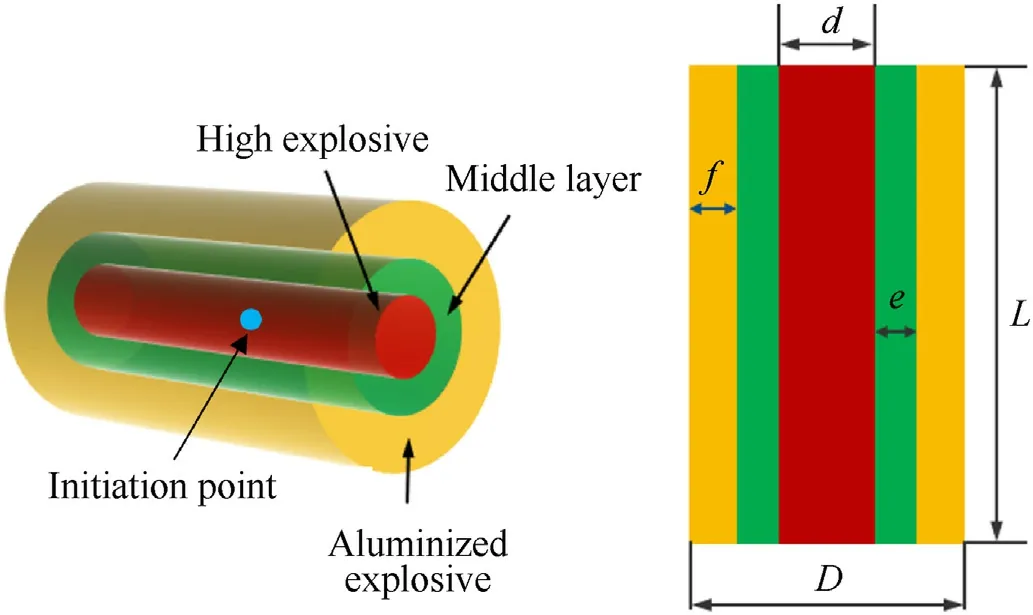
Fig.1.Schematic diagram and characteristic dimensions of multi-layer composite charge.
Upon detonate,the middle layer material cracks under the detonation of the internal high explosive.The middle layer as well as the aluminum powder from the outer aluminized explosive are quickly thrown out and react with the surrounding air.The whole process may be affected by many factors such as the type and structure of the charge,so the dimensional analysis was used to establish the prediction model of peak overpressure under singlepoint detonation.
According to dimensional analysis [18],the general function is expressed as

We set E1,P0,and ρ0as independent variables and rewrite Eq.(4)as an exponential equation of π:

According to the mass-length-time (MLT) unit system,the dimension matrix can be expressed as

α1α2α3α4α5α6α7α8α9α10 ΔpmdeagbgRE1E2P0ρ0 M1000001111 L-11110122-1-3 T-200-100-2-2-20
Where α1,α2,…α10are the dimensionless parameters,which satisfy the following relationship:

α8,α9,and α10can be expressed using α1,α2,α3,α4,α5,α6,and α7as

where π1,π2,…π7are the dimensionless π term,and the π matrix is then expressed as
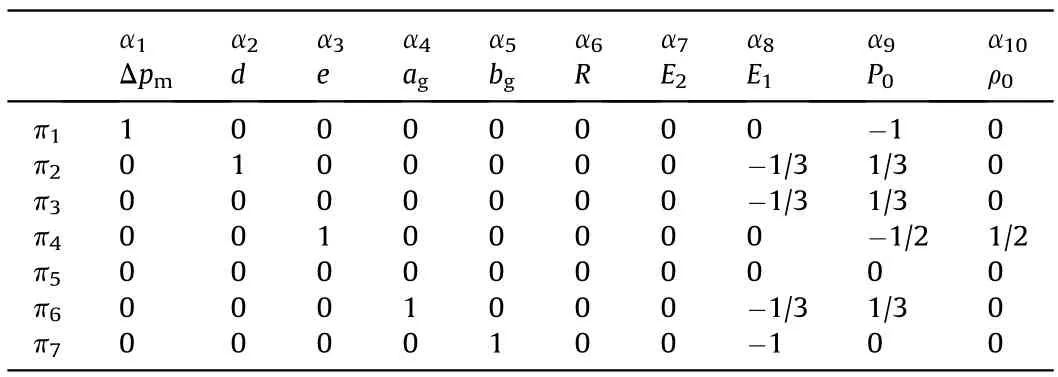
α1α2α3α4α5α6α7α8α9α10 ΔpmdeagbgRE2E1P0ρ0 π110000000-10 π20100000-1/31/30 π30000000-1/31/30 π400100000-1/21/2 π50000000000 π60001000-1/31/30 π70000100-100
The π term is written as
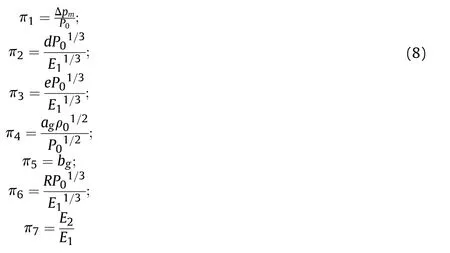
According to the π theorem [18],the dimensionless function relation is

Considering the detonation energy E=W·QV(where W is the charge mass and QVis the explosive heat),Eq.(9) is rewritten as

Considering that the products and exponentials of dimensionless numbers π are also dimensionless numbers,π2and π3can be combined as a new component,and Eq.(10) is simplified as

For a specific multi-layer composite charge,d/e,ag,bg,P0,ρ0,QV1,W2/W1,and QV2are unaffected by the aspect ratio,and Eq.(11) is finally rewritten as

Eq.(12) shows that the peak overpressure of the composite charge under single-point detonation is closely related to the mass of the inner charge,which is in line with the explosion response mechanism of the multi-layer composite charge.
2.3.Simultaneous detonation
For simultaneous detonation,the internal and external charges detonate at the same time and the role of middle layer is apparently reduced.The full detonation energy output of the composite charge can be realized,which is similar to the single charge,so the empirical formula is used to calculate the overpressure of the composite charge.Knock et al.[19,20]observed the shock waves of the cylindrical charge in axial and radial directions through highspeed photography and proposed a theoretical model to calculate the peak overpressure:

where K,K1,K2,and K3are constants related to the explosive and Z1=M1/3(L/D)1/9/R.Considering that the explosion process of multi-layer composite charge under simultaneous detonation is similar to that of the traditional single charge and the detonation energy of the charge is fully released,the calculation model given as Eq.(13) is used to calculate the peak overpressure under the simultaneous detonation of the charge in the following.
3.Numerical calculation of shock wave overpressure
In general,the geometric shape of the shock waveform of cylindrical charge near the detonation point is non-spherical and depends on the charge structure parameters and detonation mode.Sternberg et al.[21] found that the shock wave property of the cylindrical charge is mainly controlled by the aspect ratio of the charge and the position of the observation point,including the distance to the charge center and the azimuth angle relative to the charge axis.To investigate the propagation and attenuation of the shock wave for multi-layer composite charge and to verify the established model for calculating peak overpressure,the numerical simulation for multi-layer composite charge with an aspect ratio L/D=1/1,2/1,3/1,4/1 was carried out for single-point detonation and simultaneous detonation.
3.1.Calculation model
The mapping function of AUTODYN software was used to establish the two-dimensional axisymmetric calculation model of multi-layer composite charge in the following two steps.
For the simulation model in the near field (Fig.2),the Euler-Godunov solver of AUTODYN was used to establish an air zone of 0.5×0.5 m2,which was divided into 150×150 cells.The air zone was then filled with an inner JH-2 explosive (95 wt.% RDX,3 wt.% DNT,2 wt.% CZ) having a diameter of 35 mm,a middle polyurethane having a thickness of 15 mm,and an outer aluminized explosive (76 wt.% RDX,20 wt.% Al,4 wt.% Wax) having a thickness of 15 mm,with the height of the charge varying with the aspect ratio.For single-point detonation,the JH-2 explosive obeyed the Jones-Wilkins-Lee(JWL)equation of state (EOS)[22],while an ignition growth reaction model was adopted for the aluminized explosive [23].For internal and external simultaneous initiation,the JH-2 and aluminized explosives obeyed the JWL EOS.Details of the explosive parameters are given in Tables 1-3.The calculation was stopped and a.fil file was output when the shock wave reached the boundary of the model.
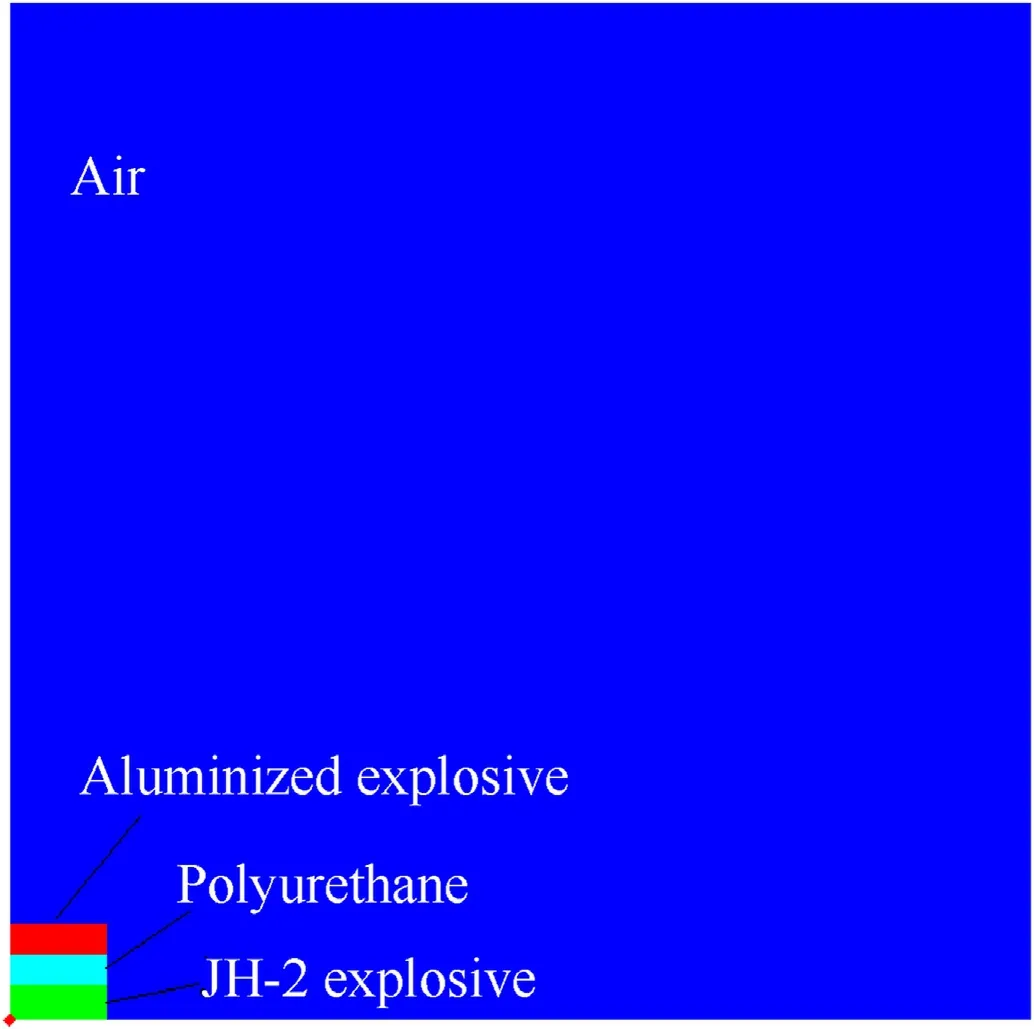
Fig.2.Near-field calculation model.
The simulation model in the far field is shown in Fig.3.The previous studies on the grid size effect revealed that the calculated overpressure curve can be considered as convergent within the size range of 1-3 cm,thus the air zone of 5 × 5 m2was divided into 400 × 400 cells for the far field model.A non-reflective boundary condition was applied to the air zone.In the calculation,the obtained.fil file was loaded for the air zone and the calculation time was reset.
To observe the development of the shock wave at different propagation distances and azimuth angles,five series of Gaussian points were set at distances of 10,20,30,40,and 50 times the charge diameter(denoted 10D,20D,30D,40D,and 50D)and angles of 0°,22.5°,45°,67.5°,and 90°to the axis of the charge as shown in Fig.4.
3.2.Effect of the aspect ratio
To investigate the effect of the charge structure on the distribution characteristics of the shock wave pressure,composite charges with aspect ratios of 1/1,2/1,3/1,and 4/1 were established as shown in Table 4.
The axial and radial shock wave overpressure curves of composite charges at distances of 10D,20D,30D,and 40D are presented in Table 5.It is seen that the axial shock wave has multiple shocks whereas the radial shock wave gradually decreases after reaching apeak.A secondary shock appears for the axial overpressure curves and even exceeds the primary peak overpressure at distances of 30D and 40D.For L/D=1,the peak overpressures in axial and radial directions are similar.As the aspect ratio increases,the radial overpressure gradually becomes greater than the axial overpressure.

Table 1 Parameters of the explosive JWL EOS.

Table 2 Parameters of the unreacted explosive JWL EOS.

Table 3 EOS parameters of the reaction rate of the ignition growth model.
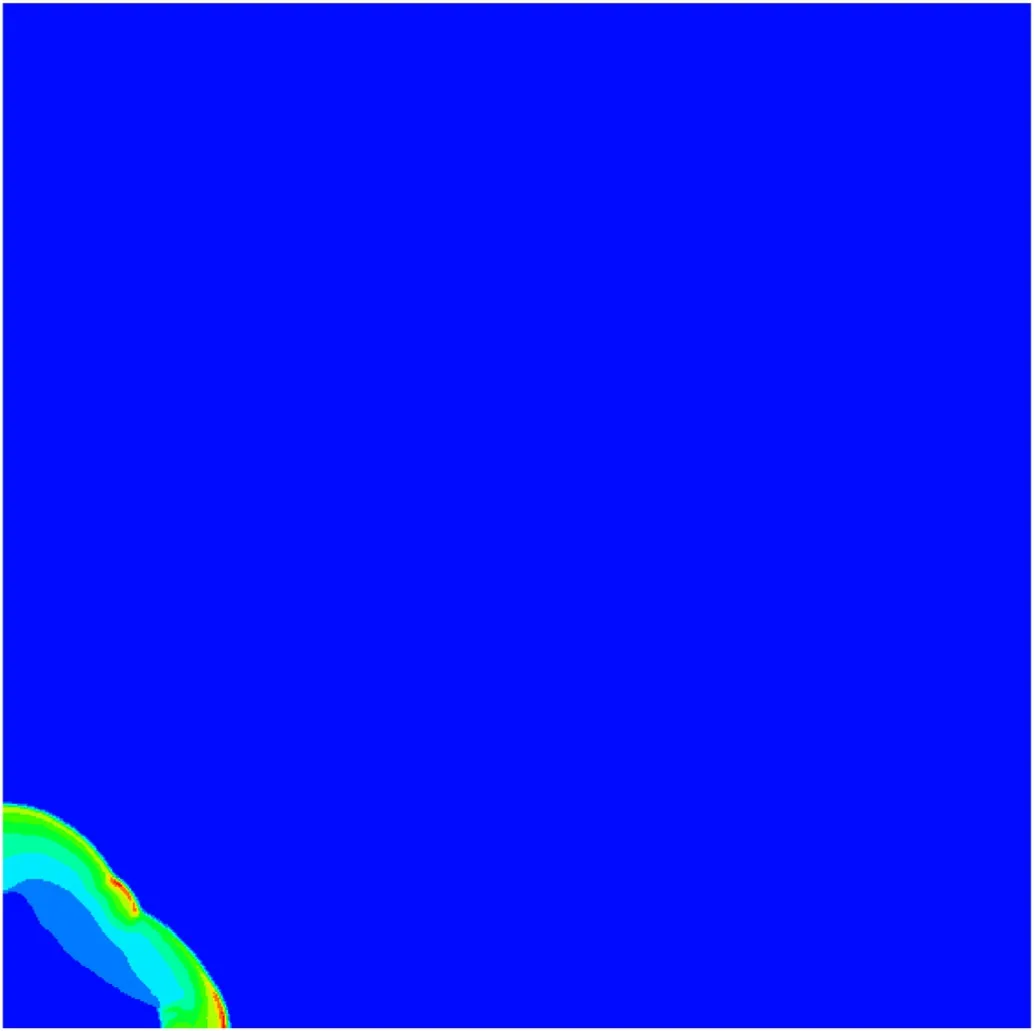
Fig.3.Mapped far-field calculation model.
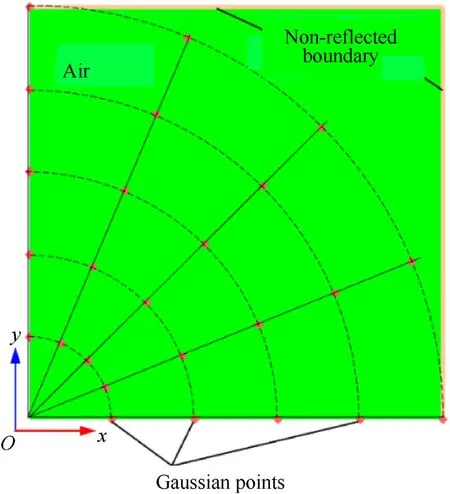
Fig.4.Distribution of Gaussian points.

Table 4 Simulation schemes for different structures of composite charge.
Considering the multi-peak phenomenon for overpressure curves,the investigated peak overpressure Δpmin the following is defined as the maximum value between the primary and secondary peaks in the overpressure.
Fig.5 presents Δpmat 0°,22.5°,45°,67.5°,and 90°for further analysis of the shock wave overpressure generated by the multilayer composite charge at other azimuth angles.The difference in the peak overpressure at azimuth angles of 22.5°-90°gradually decreases with an increase in the propagation distance and tends to disappear when the ratio of propagation distance to charge exceeds 3,possibly because of the complex interaction between the middle layer and the detonation waves generated by the inner and outer explosives before the formation of the wave front.With the propagation of the shock wave in the air,the wave front gradually evolves into a spherical shape,leading to a fairly consistent Δpmaround the charge.
The specific impulses Iscalculated based on the curves of the positive pressure zone are provided in Fig.6.It can be observed that the impulse at 0°is significantly larger than that at other azimuth angles,which may be due to the stronger shock wave energy accumulation in the axial direction of cylindrical charge.For charge with L/D=1/1,the impulses at different azimuth angles are very close since the shock wave front of the charge with lower L/D is close to a spherical shape.Another significant information presented in Fig.6 is that the difference in impulse at different azimuth angles first decreases and then increases with the increasing contrast distance.
3.3.Effect of the detonation mode
To investigate the effect of the detonation modes on the blast wave characteristics of multi-layer composite charge,the contours of pressure and the peak overpressure distribution under singlepoint detonation and simultaneous detonation were analyzed.
The contours of pressure of composite charge under singlepoint detonation and simultaneous detonation are presented in Tables 6 and 7,where CC and TC respectively refer to the singlepoint detonation and simultaneous detonation.
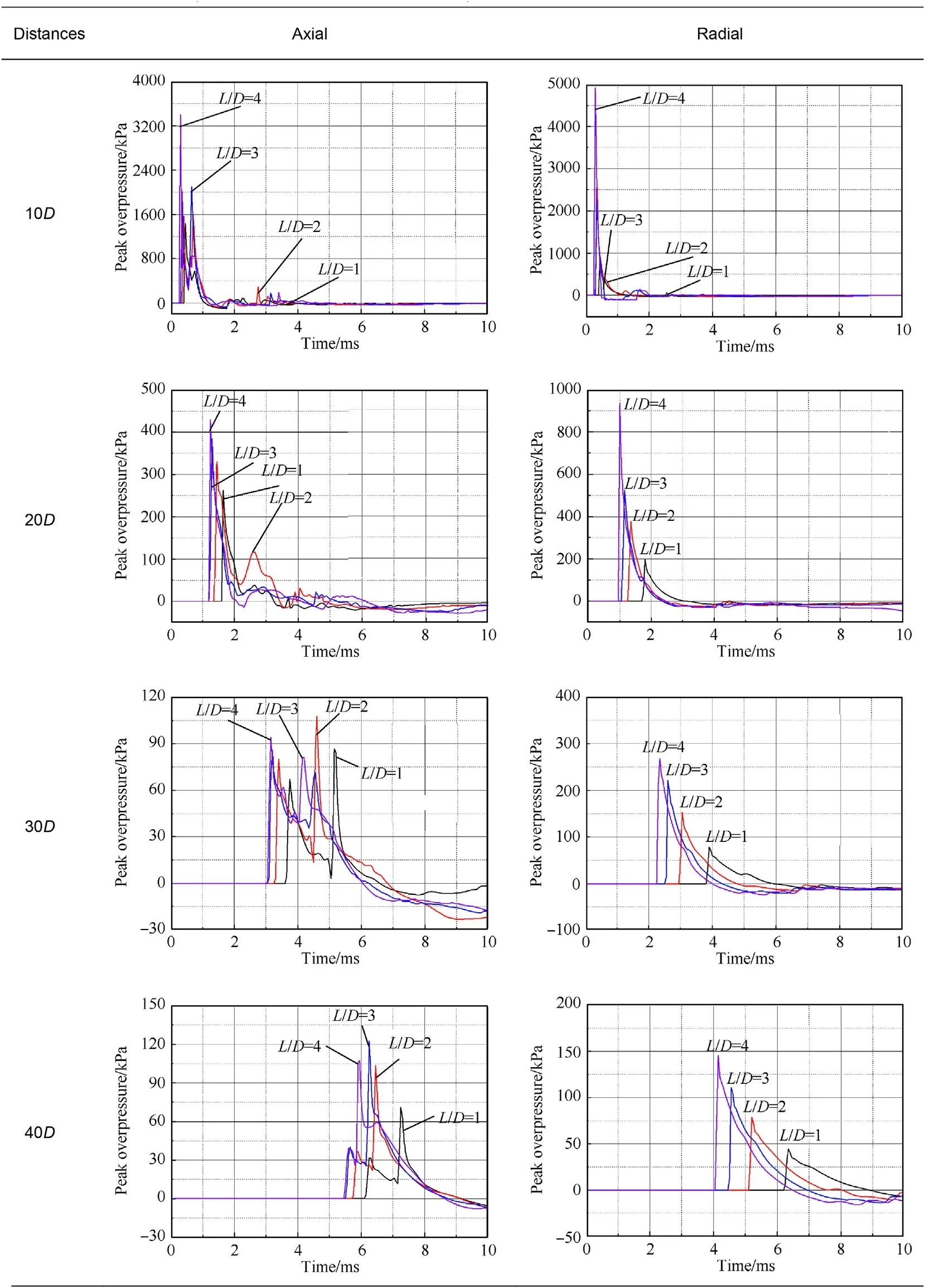
Table 5 Axial and radial overpressure curves for different aspect ratios.
The contours of pressure at t=0.5 ms show that the axial pressure is higher than the radial pressure owing to the attenuation effect of the middle layer.At t=1 ms,a higher shock wave appears at an azimuth angle of 45°owing to the interaction of the spherical detonation wave generated in the orthogonal directions,which was referred to as a bridge wave by Ismail et al.[24].Subsequently,the bridge wave collides with the axial and radial shock waves again at 2 and 3.5 ms,respectively,and the overall shape of the shock wave is finally close to spherical.
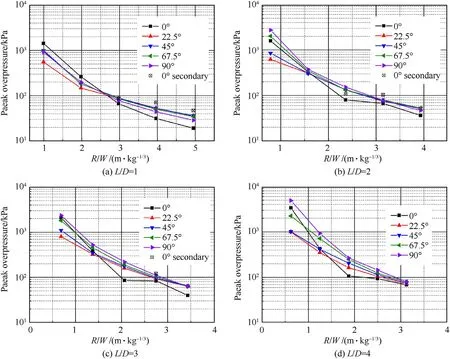
Fig.5.Comparisons of peak pressures for composite charges with different aspect ratios at different azimuth angles.

Fig.6.Comparisons of specific impulses for composite charges with different aspect ratios at different azimuth angles.
Tables 6 and 7 show that the expansion velocities of the radial shock wave under the two detonation modes are higher than those in the axial direction.The shock wave front evolves into a distinct ellipsoidal shape as the aspect ratio increases from 1 to 3.
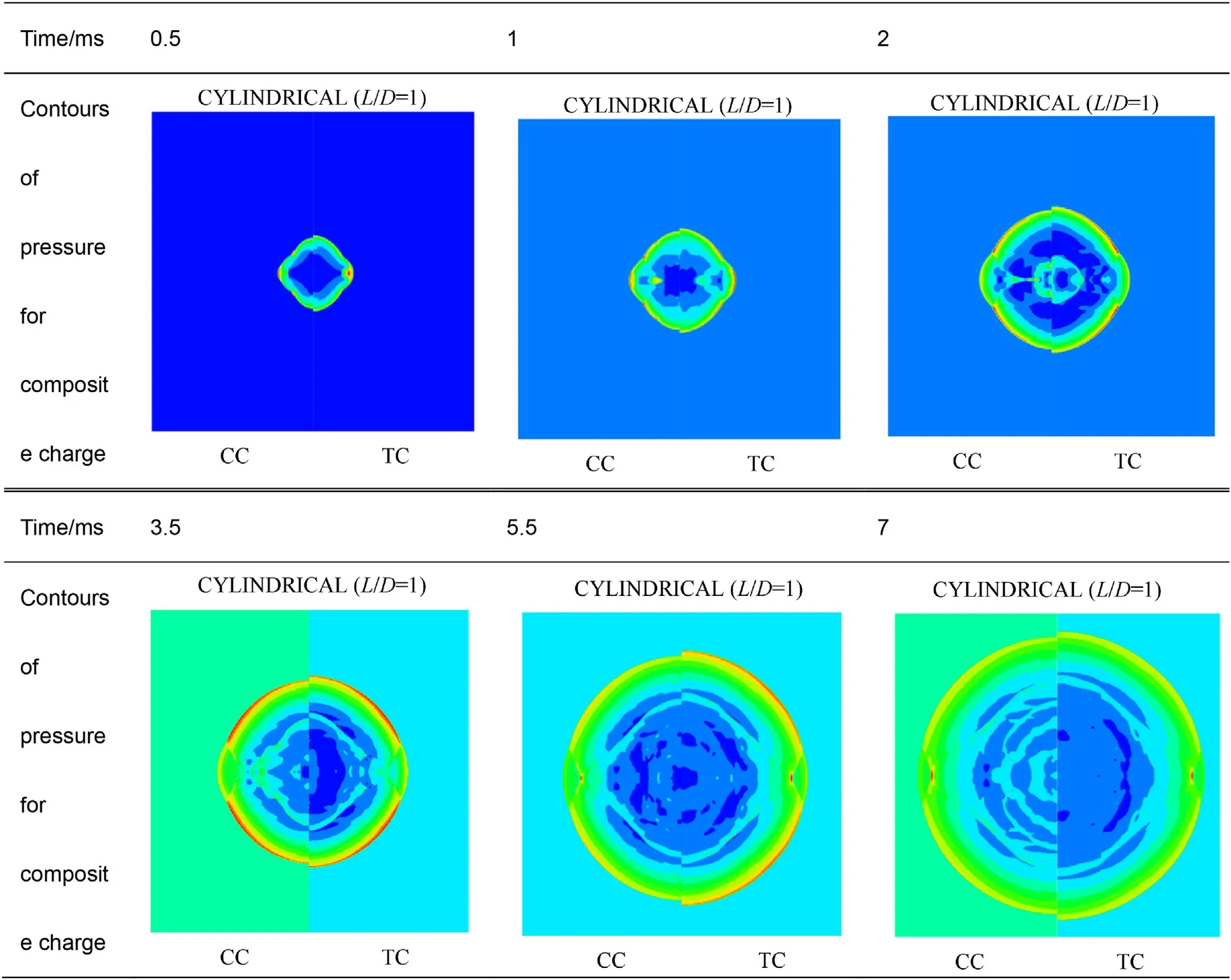
Table 6 Contours of pressure for composite charge with an aspect ratio of 1.
Fig.7 presents the relationship between the peak overpressure and the distance normalized by the charge diameter (a dimensionless number) for the investigation of the effect of the detonation mode on the shock wave of multi-layer composite charge in the far field.A clear difference is observed between the attenuation trends of the peak overpressure in axial and radial directions.The decrease in the amplitude of Δpmin the axial direction is no longer obvious when the normalized distance is greater than 30D,which may be because of the arrival of the secondary shock wave.In contrast,the overpressure in the radial direction decreases exponentially,which is similar to the case for the traditional single charge.Δpmin the radial direction is higher under simultaneous detonation than under single-point detonation,revealing the coupling of energy between inner and outer charges under the detonation mode.To further investigate the influence of explosive type on blast wave characteristics of composite charge,the peak overpressure-normalized distance relationship for single JH-2 explosive under single point initiation was calculated using the traditional model[16]as shown in Fig.7.The mass of the explosive is consistent with the composite charge of L/D=1.It can be observed that the peak overpressure of composite charge and single explosive are very close in lower normalized distance.When the normalized distance is greater than 30,the axial overpressure of single explosive is apparently lower than that of composite charge.
3.4.Applicability verification of the prediction mode
The peak overpressure for charges with different aspect ratios are provided in Figs.8 and 9 to verify the applicability of the established prediction model.To describe the relationship between the axial shock wave and propagation distance,an exponential function with R/W1/3as the independent variable is thus proposed on the basis of Eq.(12):

where k and n are constants and W=W1+W2,with W1and W2being the masses of inner and outer charge,respectively.For simultaneous detonation,the peak overpressure is predicted according to Eq.(13) using


Table 7 Contours of pressure for composite charge with an aspect ratio of 3.
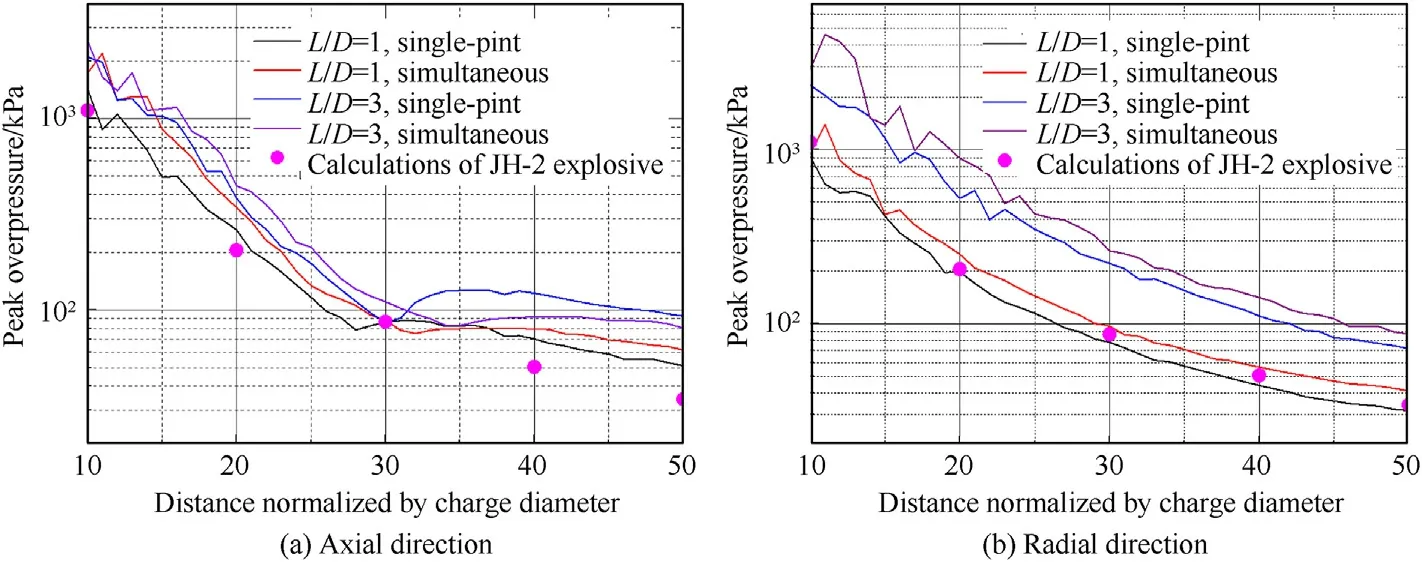
Fig.7.Relationship between the peak overpressure and normalized distance.
where k1,k2,and k3are constants.
A formula for predicting the peak overpressure in the axial direction is obtained by fitting the simulation results in Fig.8 as

for single-point detonation and

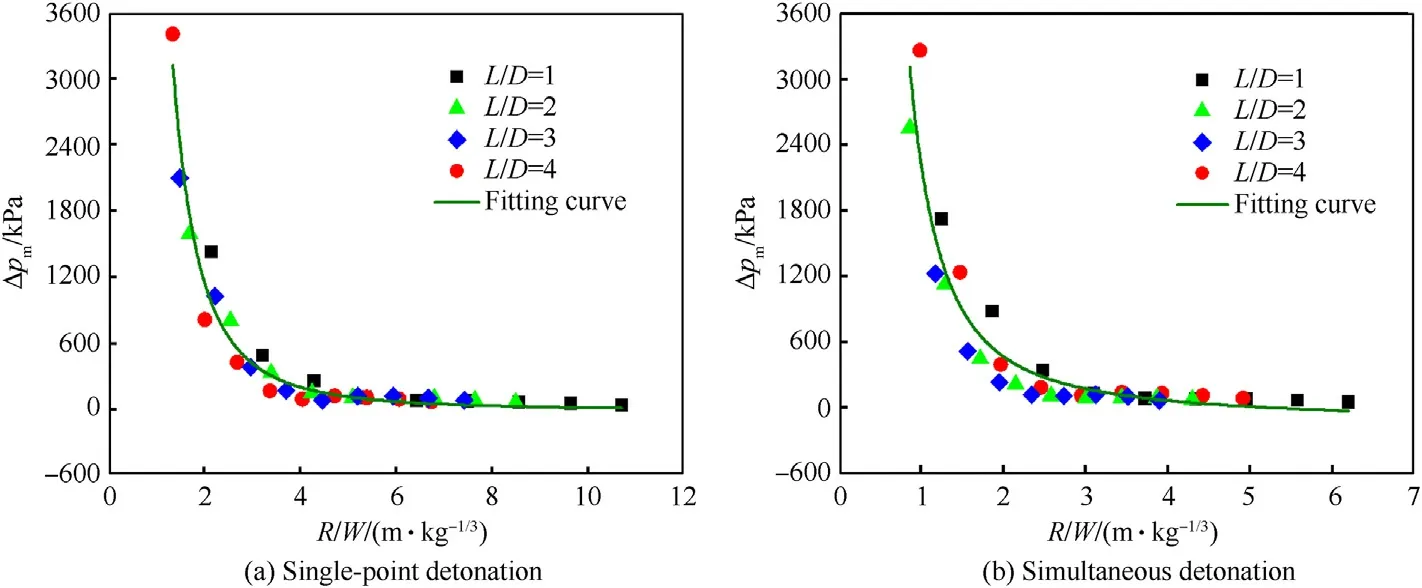
Fig.8.Relationship between the axial shock wave and propagation distance.
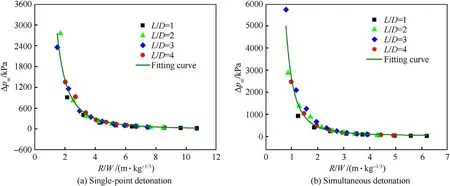
Fig.9.Relationship between the radial shock wave and propagation distance.
for simultaneous detonation.
A formula for predicting the peak overpressure in the radial direction is also obtained by fitting the simulation results in Fig.9 as

for single-point detonation and

for simultaneous detonation.
4.Test verification
4.1.Test design
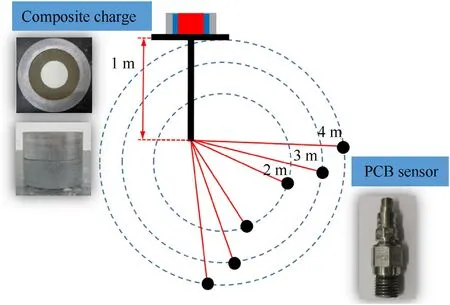
Fig.10.Schematic diagram of the test set-up and the assembled composite charge.
To verify the accuracy of the prediction model and the reliability of the numerical simulation method,the overpressure of the multilayer composite charge under different initiation methods were measured using an 113B21 piezoelectric pressure sensor (United States PCB Company).The internal and external explosives as well as non-detonative material of the tested charge (with a length of 80 mm and a total mass of about 846 g)are consistent with that in simulation.
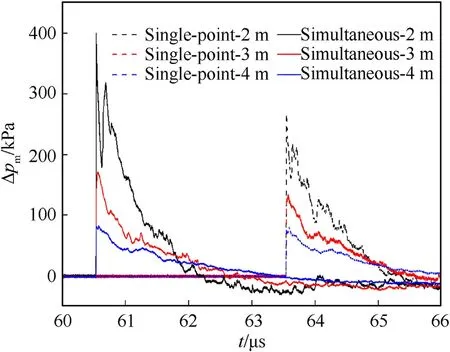
Fig.11.Overpressure curves measured at distances of 2,3,and 4 m from the charge center.
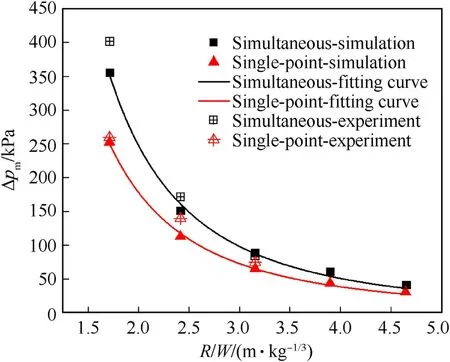
Fig.12.Comparisons of model predictions and test measurements of overpressure.
During the test,the sampling frequency was set to 1 MSa/s.The resonant frequency of the sensor is 300 kHz,and the sensitivity is 50-100 mV/(lb·in-2).The detonation was initiated at the upper end.The single-point initiation involved detonator No.8,while the simultaneous initiation was realized using a multi-point initiation network.The overpressure was measured at distances of 2,3,and 4 m to compare with the numerical simulation results,and two sensors were set at each distance.The receiving end face of the sensor was flush with the ground.Fig.10 is a schematic diagram of the test set-up and the assembled composite charge.
4.2.Results and analysis
Overpressure curves measured at distances of 2,3,and 4 m from the charge center are shown in Fig.11.As the distance from the center increases,the overpressure drops more rapidly after reaching a peak and the duration of positive pressure zone improves,reflecting the attenuation effect of the shock wave in the air.Considering the volatility of the overpressure curves,the accurate peak overpressure is determined as [25].

where χ is the attenuation coefficient and t+is the duration of the positive pressure zone.The calculated values xi,s,measured values xi,e,and the relative error εifor peak overpressure and specific impulse are listed in Table 8.The simulation results were obtained under conditions consistent with the experiment,including a rigid reflective surface used to simulate the ground.The model predictions and test measurements for peak overpressure are compared in Fig.12.
Table 8 shows that the peak overpressures at distances of 2,3,and 4 m were respectively 54.6%,22.9%,and 13.3% greater under the simultaneous detonation than under the single-point detonation.It is noted that the peak overpressures obtained from numerical simulation are similar to the experimental measurements.The overall relative error is within 14.4%,except for a distance of 3 m under simultaneous detonation.Besides,the specific impulses determined by the experiments and simulations are also very close,with an error less than 13.6%.Fig.12 shows that the error at different distances is within 16.4%,demonstrating that the theoretical model well predicted the peak overpressure of multi-layer composite charge under different detonation modes.

Table 8 Comparisons of peak overpressure and specific impulse obtained in the test and simulation.
5.Conclusion
This paper investigated the characteristics of shock wave overpressure generated by multi-layer composite charge under different detonation modes through theoretical analysis,numerical simulation,and experimental verification.The main results of the study are described as follows.
(1) A model for predicting the peak overpressure of composite charge under single-point detonation and simultaneous detonation was proposed on the basis of dimensional analysis and the explosion mechanism of the charge.It was found that the mass of the inner charge affects the peak overpressure of the charge under single-point detonation while the peak overpressure under simultaneous detonation can be determined according to the calculation formula for traditional single charge.
(2) The effects of the charge structure and initiation method on the characteristics of the overpressure field were investigated using the mapping function of AUTODYN.It was found that the overpressure curves in the axial direction exhibited a multi-peak phenomenon,and the secondary peak of overpressure even exceeded the primary peak at distances of 30D and 40D.The difference in overpressure for different azimuth angles tended to disappear when the ratio of propagation distance to charge was greater than 3.The overpressure improved under simultaneous detonation owing to the coupled effect of the detonation energy of the inner and outer charge.
(3) The experimentally measured peak overpressures at distances of 2,3,and 4 m under simultaneous detonation were respectively 54.6%,22.9%,and 13.3%greater than that under single-point detonation.The difference in peak overpressure obtained from model prediction and experiments was less than 16.4%,validating the obtained prediction model and the rationality of the numerical simulation method.
Declaration of competing interest
The authors declare that they have no known competing financial interests or personal relationships that could have appeared to influence the work reported in this paper.
Acknowledgments
The work presented in this paper has been funded by the National Natural Science Foundation of China(Grant No.11972018,No.12002336);China Postdoctoral Science Foundation (Grant No.2021M701710).
杂志排行
Defence Technology的其它文章
- Experimental and numerical analysis on suitability of S-Glass-Carbon fiber reinforced polymer composites for submarine hull
- Damage response of conventionally reinforced two-way spanning concrete slab under eccentric impacting drop weight loading
- Analysis and design for the comprehensive ballistic and blast resistance of polyurea-coated steel plate
- Positive effects of PVP in MIC: Preparation and characterization of Al-Core heterojunction fibers
- Flight parameter calculation method of multi-projectiles using temporal and spatial information constraint
- Numerical simulation of drop weight impact sensitivity evaluation criteria for pressed PBXs
